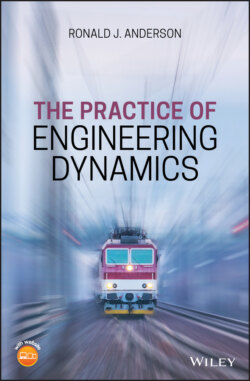Читать книгу The Practice of Engineering Dynamics - Ronald J. Anderson - Страница 18
1.5 Three Dimensional Kinematics
ОглавлениеFigure 1.5 shows a three degree of freedom robot. The horizontal arm is of fixed length and is free to rotate about a vertical axis through point with angular speed . Arm has a variable length and is free to rotate about an axis passing through points and with angular speed . The end effector is located at point . Of interest for the kinematic analysis are expressions for the absolute velocity and acceleration of the end effector.
Figure 1.5 A three dimensional robot.
As a first step we define the right handed coordinate system (, , ) fixed in the arm . This is a rotating coordinate system with angular velocity .
The process of finding the absolute velocity and acceleration of point is just as outlined in Section 1.2. The first step is to find a fixed point. In this system, point serves the purpose as it has no velocity or acceleration.
The next step is to define a position vector that goes from to . This is the vector shown in Figure 1.6. Notice that it goes through space from to and its rate of change cannot be described directly using the motions of the physical components of the system.
Figure 1.6 Relative position vectors.
We must, in fact, work with relative position vectors that go from the fixed point to the point of interest by passing from joint to joint. In this case, we define first a vector that goes from to () and then add to it a vector that goes from to (). That is,
(1.23)
By definition, the absolute velocity of is the time rate of change of its position with respect to a fixed point. That is,
(1.24)
which, upon substitution of Equation 1.23, becomes,
(1.25)
which in turn becomes,
(1.26)
where we see that the absolute velocity of can be expressed as the sum of the velocities of points in the vector chain relative to previous points in the chain so long as the first point is stationary.
Simply differentiating Equation 1.26 with respect to time gives the corresponding expression for accelerations.
(1.27)
With respect to the particular system being considered here, we can write,
(1.28)
and,
(1.29)
Considering first the position of with respect to we see that the length is constant so there will be no rate of change of magnitude of the vector but there will be a rate of change of direction since the coordinate system is rotating. We find,
(1.30)
We differentiate again, noting that is not constant so that there will be a rate of change of magnitude this time, and find,
(1.31)
The rate of change of is a little more complicated for two reasons. First, the vector is not in the body to which the coordinate system being used is fixed so there will be a rate of change of magnitude arising from the time derivatives of the trigonometric functions. Second, the vector itself is not of fixed length so terms involving the rate of change of will appear. Differentiating yields,
(1.32)
which, noting that (see Figure 1.5), expands to,
(1.33)
Finally, we differentiate to get as follows.
(1.34)
which, after considerable effort and again noting that , expands to,
(1.35)
If you have worked through the derivation of Equation 1.35 you will be aware that the probability of making a mistake when deriving equations such as this is high. A quick, approximate check on the accuracy of your work can be made by verifying that every term in the acceleration expression has dimensions of acceleration or, more simply, contains two derivatives of displacement variables. That is, terms like are obviously accelerations whereas terms like might require a little thought before realizing that is the second derivative of an angle and must be scaled by a length, in this case , in order to be a translational acceleration. Products of angular velocities such as and have two derivatives of angles multiplied together and are again scaled by a length, , to become translational accelerations. In addition, it is somewhat comforting to see several terms that have the Coriolis factor of 2 associated with them. Suspicion should be raised when factors other than 1 or 2 are seen in acceleration expressions.
We now simply add the relative acceleration vectors to arrive at the absolute acceleration of point . That is,
(1.36)
